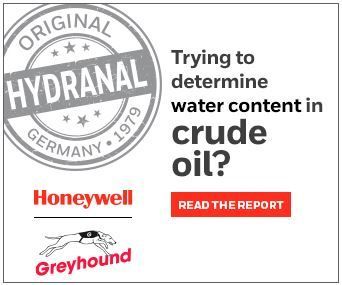Water determination in crude oil by Honeywell
HYDRANAL™ Laboratory Report L 108

From the analysis of many different oils, we have learned that intensive homogenization of samples using a homogenizer or by ultrasound is a fundamental prerequisite for reproducible results.
Six different crude oil samples that we analyzed had water contents of between 0.05% and 0.32%, and for sample oil the same result was obtained using both analytical methods.
Crude oil requires different solvents to aid solubility: chloroform to dissolve the oil and xylene to dissolve the tar components. If the tar is not finely dispersed, it can coat the electrode, which leads to indication problems.
According to ASTM D 4377-00, in analysis using a pyridine-free reagent, a mixture of a Karl Fischer solvent (for example Hydranal-Solvent) and xylene must be added to the titration vessel. Hydranal-Solver (Crude) Oil fulfills all these requirements.
Procedure for volumetric one-component titration:
Add 30 mL Hydranal-Solver (Crude) Oil to the titration vessel and titrate to dryness using Hydranal-Composite 5. Accurately weigh-in by difference approximately 4 g sample and titrate the water content using Hydranal-Composite 5. Hydranal-Water Standard 10.0, Hydranal-Water Standard 1.0, and Hydranal-Standard Sodium Tartrate Dihydrate are suitable for determination of the titer or control of the volumetric determination.
Procedure for coulometric titration:
Add approx. 100 mL of Hydranal-Coulomat Oil to the anode compartment of a coulometric cell with a diaphragm and then add Hydranal-Coulomat CG to the cathode compartment to the same level (usually 5 mL). Instead of Hydranal-Coulomat Oil, a mixture of 70 mL Hydranal-Coulomat A and 30 mL Hydranal-Xylene could also be used. The machine is switched on and it titrates automatically to dryness. When the instrument is showing a low, stable drift, samples can be weighed in by difference using a syringe.
Hydranal-Water Standard 1.0 and Hydranal-Water Standard 0.1 PC are suitable for controlling the coulometric cell. The coulometric method is cumulative. After the first determination, the solution becomes dark and visual control is not possible. We have, however, found that results from one oil source are reproducible and that there are therefore no indication problems for the analysis. During our tests, we injected a total of approx. 30 g crude oil into the cell. Each individual analysis was of between 1 and 2 g oil, depending on the water content of the sample.

CONTACT US
Tel: +44 (0) 151 649 4000
Email: marketing@greyhoundchrom.com
FOLLOW US
YOU MAY ALSO BE INTERESTED IN OUR NEWSLETTER















